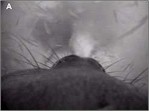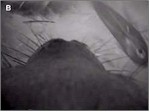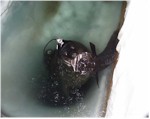|
Imagine a lion, poised to bring down its
prey, drawing and holding a breath, then
giving chase for 20 minutes. Few, if any,
large land-based predators could do such
a thing. But seals and other marine mammals
regularly do.
Now a team of researchers, supported by
the National Science Foundation (NSF),
has devised a way to enter the alien world
of Antarctic Weddell seals as they hunt.
Using a small video system and data logger
attached to the seals' backs, they have
tracked the animals below the sea ice
of McMurdo Sound.
"We can now make observations at depth
and relate them to the underwater movements
of animals as researchers have done with
lions and other large predators for years
in terrestrial habitats," said Randall
W. Davis, a marine biologist at Texas
A&M University, the team leader.
Davis and his colleagues, Terrie W. Williams,
of the University of California, Santa
Cruz and Lee A. Fuiman, of the University
of Texas, describe their techniques in
the Feb. 12 edition of Science.
Although others have mounted cameras on
marine mammals before, Davis stressed
that the value of his research is the
simultaneous recording of video, audio
and data on swimming performance and environmental
characteristics. The data collected enables
the researchers to compute the three-dimensional
path of individual dives.
"This combination of technologies will
allow for major advancements in our understanding
of the underwater behavior of marine mammals,"
noted Polly Penhale, who oversees the
U.S. Antarctic Program's biological and
medical research.
Davis said that many of the project's scientific
findings are preliminary, but intriguing.
For example, although Weddells have a
known range of vocalizations comprising
34 different sounds, they seldom used
sound underwater. This may indicate that
the seals do not use echo-location to
find their prey.
However, seals, unlike humans, have an
exceptional ability to locate the source
of a sound underwater. "That sort of 'passive
sonar' could be quite important, but it
is very hard to verify experimentally,"
Davis said. The camera also recorded seals
apparently using surface light penetrating
the ice to silhouette Antarctic cod, a
prey species, indicating that visual clues
may be important to hunting seals.
The sound and video equipment, he noted,
will allow greater insight into the behavior
of animals that regularly range up to
three kilometers and return safely to
a single, four-foot-wide breathing hole.
"What captures the imagination of both
scientists and non-scientists in this
research is the ability to vicariously
travel with these animals as they descend
to great depths," he stressed.

The swimming path of a 10-minute, 20-second
dive during which a Weddell seal made
contact with an Antarctic cod. The solid
circle marks the breathing hole and the
star marks the point of contact between
the seal and the fish. The total distance
travelled was 760 meters.
|
 |
|
 |
Images
taken with a head-mounted camera, showing
forehead and muzzle

A seal blowing air out of its nostrils
and into crevices in the sub-ice platelet
layer where two fish are hiding.
Photos Credit: courtesy of Randall
Davis and Lee Fuiman
Select image for larger version
(Size: 4KB)

Moments after the seal finishes blowing
air, one of the fish is flushed out and
darts past the right side of the seal's
head.
Photos Credit: courtesy of Randall
Davis and Lee Fuiman
Select image for larger version
(Size: 4KB)

A Weddell seal, equipped with camera
and data recorder, surfaces at a breathing
hole, with a fish in its mouth.
Photos Credit: courtesy of Randall
Davis and Lee Fuiman
Select image for larger version
(Size: 11KB)
 Note
About Images Note
About Images
|





